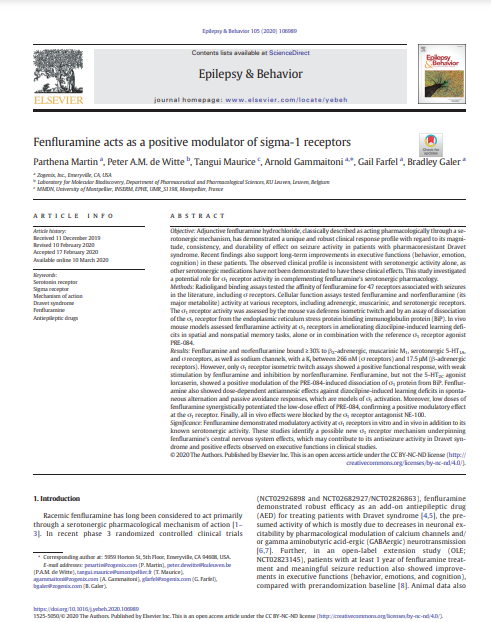Fenfluramine acts as a positive modulator of sigma-1 receptors
March 2020
Abstract
Objective
Adjunctive fenfluramine hydrochloride, classically described as acting pharmacologically through a serotonergic mechanism, has demonstrated a unique and robust clinical response profile with regard to its magnitude, consistency, and durability of effect on seizure activity in patients with pharmacoresistant Dravet syndrome. Recent findings also support long-term improvements in executive functions (behavior, emotion, cognition) in these patients. The observed clinical profile is inconsistent with serotonergic activity alone, as other serotonergic medications have not been demonstrated to have these clinical effects. This study investigated a potential role for σ1 receptor activity in complementing fenfluramine's serotonergic pharmacology.
Methods
Radioligand binding assays tested the affinity of fenfluramine for 47 receptors associated with seizures in the literature, including σ receptors. Cellular function assays tested fenfluramine and norfenfluramine (its major metabolite) activity at various receptors, including adrenergic, muscarinic, and serotonergic receptors. The σ1 receptor activity was assessed by the mouse vas deferens isometric twitch and by an assay of dissociation of the σ1 receptor from the endoplasmic reticulum stress protein binding immunoglobulin protein (BiP). In vivo mouse models assessed fenfluramine activity at σ1 receptors in ameliorating dizocilpine-induced learning deficits in spatial and nonspatial memory tasks, alone or in combination with the reference σ1 receptor agonist PRE-084.
Results
Fenfluramine and norfenfluramine bound ≥30% to β2-adrenergic, muscarinic M1, serotonergic 5-HT1A, and σ receptors, as well as sodium channels, with a Ki between 266 nM (σ receptors) and 17.5 μM (β-adrenergic receptors). However, only σ1 receptor isometric twitch assays showed a positive functional response, with weak stimulation by fenfluramine and inhibition by norfenfluramine. Fenfluramine, but not the 5-HT2C agonist lorcaserin, showed a positive modulation of the PRE-084-induced dissociation of σ1 protein from BiP. Fenfluramine also showed dose-dependent antiamnesic effects against dizocilpine-induced learning deficits in spontaneous alternation and passive avoidance responses, which are models of σ1 activation. Moreover, low doses of fenfluramine synergistically potentiated the low-dose effect of PRE-084, confirming a positive modulatory effect at the σ1 receptor. Finally, all in vivo effects were blocked by the σ1 receptor antagonist NE-100.
Significance
Fenfluramine demonstrated modulatory activity at σ1 receptors in vitro and in vivo in addition to its known serotonergic activity. These studies identify a possible new σ1 receptor mechanism underpinning fenfluramine's central nervous system effects, which may contribute to its antiseizure activity in Dravet syndrome and positive effects observed on executive functions in clinical studies.

